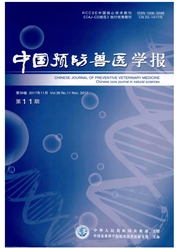

 中文摘要:
中文摘要:
Hfq是一种介导细菌非编码小RNA (sRNA)与其靶标mRNA结合的伴侣蛋白,可协助多种sRNA在转录后水平调控基因表达。本研究通过λ噬菌体的Red同源重组系统构建了肠炎沙门氏菌hfq缺失突变株SE50336△hfq。利用荧光定量PCR技术分析了hfq突变株中鞭毛主要结构蛋白fliC的表达情况。结果表明与野生株相比,hfq突变株fliC的表达量明显下降,只有野生株的3.7 %。细菌运动性试验表明突变株在半固体培养基上的运动能力减弱。以上结果表明Hfq蛋白可调节鞭毛结构蛋白FliC的表达,造成FliC蛋白表达量明显下降,鞭毛的合成受到抑制,从而导致肠炎沙门氏菌的运动能力减弱。
 英文摘要:
英文摘要:
Salmonella enteritidis is an important intracellular pathogen which could infect humanbeing and animals, and cause enteritis or systemic disease. Hfq is a kind of RNA chaperone protein that mediates the binding of small non-coding RNAs to target mRNA and assists in post-transcriptional gene regulation in bacteria. In this study, we constructed S.enteritidis hfq deletion mutant SE50336△hfq by λ-Red recombination system and then analyzed the expression of flagellin gene fliC by quantitative real-time PCR. It was found that the gene expression of fliC was decreased to about 3.7% in hfq mutant than that in wild type strain. The motile ability of the mutant on semi-solid agar was decreased evidently compared with the wild type strain. The results indicated that the protein Hfq was able to down regulate the mRNA transcription level of flagellin gene fliC, resulting in decreased FliC protein expression. Moreover, the flagella synthesis was repressed which led to attenuation of motile ability of the mutant bacteria.
 同期刊论文项目
同期刊论文项目
 同项目期刊论文
同项目期刊论文
 Antimicrobial resistance, presence of integrons and biofilm formation of Salmonella Pullorum isolate
Antimicrobial resistance, presence of integrons and biofilm formation of Salmonella Pullorum isolate 期刊信息
期刊信息
